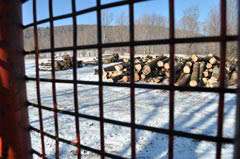“It’s a weird time in the wood industry,” said Bob De Geus, wood utilization specialist with Vermont’s Department of Forests, Parks and Recreation. He paused then, trying to synthesize hard data, speculation, and the fighting spirit of the men and women in the woods business into a sound bite he could give a journalist who was asking way too broad a question.
“The crash has been bad but it’s worse than that – mills have been limping along on subsistence incomes for twice that long,” he said. “I think it’s safe to say that sawmills are having a thoroughly filthy time of it.”
Things haven’t been this bad in a long time for the wood industry in the Northeast. National lumber markets hit historic highs in the past decade, then crashed right along with the speculative housing binge. Softwood markets, which directly fed the housing boom, have declined dramatically. Pulp and paper markets are down and stagnant. Hardwood markets are pale visages of their former selves. As recently as 2007, New York mills were buying prime cherry sawlogs for over $1,000 per thousand board feet; today, a logger would be lucky to see half that.
This hurt seeps though the entire food chain. Sawmills have cut hours, cut inventories, scrambled to diversify. Wausau’s paper mill at Jay, Maine, is gone. Ethan Allen furniture recently closed plants in New York and Vermont. Maine’s flagship furniture firm, Moosehead, recently went through a painful bankruptcy.
In nature, the web of life is a familiar concept. If the mycorrhizal fungi on the forest floor are damaged, the entire forest feels it – from the trees to the mice to the foxes. The same concept holds true in the rural economy.
“As a society, we don’t necessarily notice when something isn’t going well,” said De Geus. “Or if we do notice – if we do pass an empty log yard, a silent mill – we look at it abstractly; we see it as just another bad thing. The problem is that it’s easy to overlook the ripple effects this way. There’s a tendency to think that the forest products industry directly benefits a landowner. While this is true, there’s a much larger, community-wide benefit as well. A working forest provides property taxes that pay for local roads and schools. It provides jobs in the harvesting, transportation, and processing sectors. The ripples go out from here and touch many people beyond the landowner and the businesses that handle the wood.”
So is there any good news to report? It depends on who you talk to. One log buyer I spoke with said it’s not so much that he sees light at the end of the tunnel; it’s more like someone’s walking around in the dark tunnel with a very weak candle. Still, there is light.
“I had a mill owner tell me recently we’re still hemorrhaging, but not as bad as we were,” said Sarah Smith, a forest industry specialist at UNH Cooperative Extension. Smith says that pine markets have ticked up slightly to fuel the renovation markets but that new home sales are still stagnant.
In central New York, Ken Decker, forest manager at Quality Hardwoods, reports the same thing. “Things are slow,” said Decker, but we’re starting to see some bright spots in hard maple, in red oak. Things have been bad, so supply is down; demand is starting to come back a little. It’s not going to happen in 30 days, but things will recover.
Chip Bessey, a forester who operates log and pulpwood concentration yards in Maine and New Hampshire, reports that folks in the business have hunkered down to weather the storm.
“Most of the people who are still in this business – whether they’re mills, loggers, or truckers – are smart people,” said Bessey. “They’ve reduced their operating costs and improved efficiency. They realize things aren’t going to get any better for a while, and they’re watching their pennies.”
De Geus echoed this sentiment.
“The timber industry is among the least-regulated markets in the U.S.,” he said. “There’s almost no government management – compare this to dairy for a gross example. As a result, the men and women in this industry are accustomed to rough cycles. Many of these are family businesses that have been built up over generations, so they know how to manage long term for these savage cycles.”
Fuel wood remains a bright spot. Region wide the biomass industry is evolving – albeit slowly. The markets haven’t been fully realized yet, but the promise is there.
Firewood continues to sell well. One log buyer I spoke with in northern Vermont said that all the #2-grade beech, red maple, and ash sawlogs that he was buying were being processed and sold as firewood. Low-grade red oak was teetering right on the edge of being worth more to burn than to saw into boards. The mill this buyer worked for was using their lumber kilns to dry fuel wood; not the most efficient use of the kilns, but it was keeping people in work.


